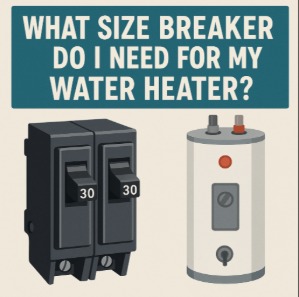
You may be new to electrical work but wish to install a water heater circuit breaker, or you want to replace a tripping breaker with a normal sized one.
Installing a water heater breaker is easy, however, you must use the correct size of circuit breaker, normal gauge wire and also observe the national electric code requirement.
A residential water heater requires a 30 amp breaker, wired to a dedicated 240 V circuit using a 10 AWG wire size for maximum performance.
Though heater tanks come in different sizes, ranging from 10 gallon water heaters to 100 gallon water heaters, following the guide in this article will help you choose the right size one for your water heater.
The water heater should be on a 30 amp dedicated circuit without any other appliances.
Importance of using the right sized circuit breaker for your water heater
Choosing the right size breaker for your electric water heater will help in the following ways:
Safety: Circuit breakers protect your electrical system from power surges and electrical fires. If you install a small-sized device, it may trip frequently, putting your home at risk of an electrical hazard.
Efficiency: A breaker that is too large for your water heater can waste energy and increase your electricity bill.
If the breaker is too small for your water heater, it may not provide enough power, leading to inefficient heating and longer wait times for hot water.
Compliance: Building codes and regulations require specific circuit breaker sizes for water heaters based on their wattage and voltage.
Failing to comply with these rules can result in fines or other penalties.
Factors that can determine the size of the breaker your water heater needs
The following factors can determine your water heater breaker size.
- Voltage: The first factor to consider when selecting a breaker for your water heater is the voltage. Average residential water heaters operate on 220 to 240 volts, and a 240 V water heater will need a 30 amp breaker to work effectively.
- Wattage: The wattage of your water heater also plays an important role in determining the breaker size. The higher the wattage, the more electricity it draws, and the larger breaker you will need.
- Amperage: Amperage is a measure of electrical current flow. You will need to ensure that the circuit breaker you choose can handle the amperage of your water heater. You can find this information on the manufacturer’s specifications or on the water heater’s nameplate.
- Electrical code requirements: The National Electrical Code (NEC) provides guidelines for the minimum circuit breaker size for various types of appliances, including water heaters. It’s important to ensure that the breaker size you choose meets these requirements.
How to choose the right size breaker for your water heater tank
To ensure you choose the correct breaker size for your water heater, you must follow these steps:
Check the wattage and voltage rating of the water heater
The information about the wattage and voltage of the heater tank is usually on the label sticker near the thermostat control panel, or power cord base.
While most residential water heaters are 4500-watts, and run on a 240-volt system, some commercial-grade units can be more than 5500 watts or less.
Calculate the maximum current your water heater will need
You can do that using this Ampere formula, which is I (amps) = P (watts)/ V (volts).
Example: Let’s assume you have a 4500 watt water heater on a 240 volt dedicated circuit.
The amp will be 4500/240 = 18.75
Apply the NEC 125% continuous load rule
The maximum current in amps your electric water heater will need is 18.75. However, you must observe the NEC rule on circuit breaker size, which states that the breaker size should always be 125% of the maximum continuous load.
To achieve this, you divide 125 by 100 and multiply the result by 18.75.
That is: 125/100 x 18.75 = 23.4375 amps.
A 25 amp breaker can carry a water heater, but for maximum protection, it is recommended that you use a 30-amp breaker.
Use a normal gauge wire
A residential water heater will need a 10 gauge wire wired to a 30 amp double pole breaker to perform very well. Using lesser wire gauges may lead to electrical fire and other surges.
Conclusion
Now that you have seen the benefits and how to choose the correct size of breaker for your heater tank, I encourage you to apply it in your homes to reduce electrical hazards.
Related articles